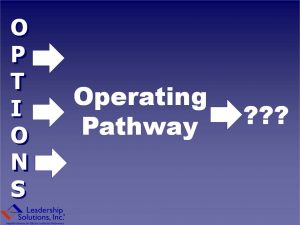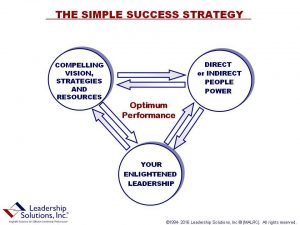by Peter A. Arthur-Smith, Leadership Solutions, Inc.®
“American business is paying people (often with lots of benefits) to work at somewhere between 15 and 37% of capacity.” Ari Weinzweig, Co-CEO of Zingerman’s and author of book “Being a Better Leader” –Published by Zingerman’s Press, Ann Arbor, MI.
 |
At a recent client session, this writer’s host was faced with a typical leadership dilemma: “How to relate even more closely with my team members, so that their engagement and productivity would increase?” Together we developed a range of options, drawing upon the option solving technique, with ying and yang bookends –as described in our most recent article: ‘Decision Clarity – “Innovation through Smart Decisions.”’ Bearing in mind the above opening quote, her desire for team members to contribute more sounds like a brilliant idea; in view of big, likely staff contribution shortfalls to be found in every organization.
Her preferred option turned out to be: ‘Pursue quarterly individual sessions focused on each team member’s progress.’ Once her choice was made, this writer encouraged her to immediately scope out an operating pathway or success strategy. So many executives and those at team-leader level positions and beyond overlook this highly important step for any leadership assignment…no matter the scope of their role, small or large. Both their organization and team members are looking for a success strategy: otherwise, anyone in a position like yours is probably going to find themselves in a leadership hole right from the get-go. Few people are going to be particularly excited about a leaders stance without a success strategy or operating pathway in clear view.
 |
The paradigm above represents a typical success strategy or operating pathway, namely:
» Compelling vision, strategies and resources required.
» Direct and indirect people power.
» Your enlightened leadership.
In the case of: ‘Pursuing quarterly individual sessions focused on each team member’s progress:’ The client used this as her overall vision, to be complemented by specific strategies. These turned out to be:
» Preparing myself and my team members for a session.
» Using insightful questions to fully engage their attention and
participation.
» Follow-through activities.
»Making it a positive experience to encourage repetition.
(NOTE: We will return to these strategies as we move along.)
With her vision and complementary strategies in place, she could now turn to people power. People are part of her resources, too, looking for the right members and skill set. Other resources include having sufficient know-how to “Prepare myself and my team members,” as well as the right financial, information and support resources. She has five client managers – pity they’re not called client advocates or client enablers – who differ in terms of cultural background, age and experience. Her main challenge, as described earlier, is to maximize their contribution and teamwork.
Such a desirable outcome is way more likely to occur with enlightened leaders, rather than utilizing traditional efficient managers, because team members will then find her a more genuine mentor, who stimulates a team atmosphere, and invokes the power of PEACAM, where:
P= Compelling PURPOSE. It can be infused by asking the right mentoring questions to engage them, such as –“What’s going right?” followed by “What would make things even better?” Questions like these inspire a positive reaction and will engage her client managers to search for an even better client purpose and solutions. Consequently, they will be appreciated by their clients even more. Each client manager is then more likely to act on their own ideas, and sense of purpose, rather than purely their executive’s ideas.
E= Sense of EQUALITY. By preparing herself properly for this team member moment, rather than doing it on the fly – because many managers don’t see such activities warranting their time -: her client managers will regard her as treating them with respect. And, by using a mentoring stance, she will approach them in a mature and dignified way, rather than talk down to them.
A=Feeling of ACHIEVEMENT. By asking the earlier question, “What’s going right?” each client manager or enabler is constructively challenged to reflect on their client accomplishments to date. Followed by, “What would make things even better?” which automatically gains their attention toward likely future accomplishments.
C= Tasting CAMARADERIE. Calling team sessions to discuss mutual progress and successes will incite team interaction and motivate members to help each other along…as opposed to compete with each other, as per the traditional model. Such team interaction will assist them in coming to terms with their different cultural backgrounds.
A= Perception of AUTONOMY. As her client managers or enablers discover their optimum pathway, through these Socratic questions, they will feel a sense of empowerment and trust normally associated with a degree of autonomy. They will gain a sense of doing the right thing without the need for continual guidance.
M= Savoring MASTERY. By causing her client managers or advocates to prepare themselves properly for these sessions, as well as induce more know-how through their Socratic dialog, their level of knowledge and mastery will continue to climb. The right knowledge can give people a great feeling of self-confidence.
So far through all these different steps, this client executive will have demonstrated enlightened leadership. It will engender an enlivening spirit and extra effort by her team members. Preparing herself to pursue these mentoring sessions with the right positive frame of mind, rather than viewing them as an imposition, will go a long way to elicit the best response from her client managers or enablers. Asking insightful questions and listening intently will have the greatest impact. Bulletized and constructive notes should be taken during the meeting so that both parties can refer to them on an ongoing basis. Eventually the session will be cemented by the mentor asking the question: “How can I be of greater value to you going forward?”
Such a closing question is a great leveler and equalizer. It also enables executives to understand whether (s)he is doing enough to ‘make it possible for his/her people to succeed.’ Making it possible for people to succeed is another cornerstone of enlightened leadership. It’s not possible to make people succeed. You can only make it possible for them to succeed: through the right framework of purpose, resources, objectives, camaraderie, self-reliance, values, working principles and know-how.
At the end of the day, follow-through activities after each quarterly event with encouragement and clear acknowledgment of successes, as well as further mentoring where necessary, makes perfect sense. This should be done with a counselor’s skill rather than giving your people the feeling that you’re looking over their shoulder to inspect them. With such an enlightened attitude and with diligent follow-through, based upon the constructive notes developed at each quarterly session, your people will feel well respected, engaged and committed to succeed. Their diligence will directly correlate to your diligence in positive follow-through.
And so that earlier option solving exercise by a client looking at her options for getting closer to her team members, in order to further raise their engagement and productivity, has now morphed into a full-fledged operating pathway or success strategy. Note that hers and your emphasis is now on discovery, positive client manager activities and commitment to do even better. Why don’t you try this, too?
A similar, three-prong success strategy – see first page pictogram – can be applied to all manner of organizational situations. Yet it should be utilized within the spirit of enlightened leadership, rather than a traditional top-down management approach, in order to experience the best results.
To find out more about converting an option into an operating pathway, talk with:
